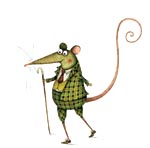Country mouse on swifts
Mark says swifts are a sign of summer, and flying high, these beautiful birds are also a sure sign of good weather


Swifts have appeared in fair numbers over southern England. I spied a screaming party hurtling over Clapham Junction train station through the carriage window, and many villages and small towns seem to be blessed with their presence. They are remarkable and mysterious birds and are the totem above all others for many bird lovers as the harbinger of summer, replacing the swallow and the cuckoo.
The poet Edward Thomas captured their energy in his poem Haymaking, describing them being ‘as if the bow had flown off with the arrow'. For countrymen, the sight of swifts flying high is a sure sign of good weather.
* Subscribe to Country Life and save; Get the Ipad edition
They can't feed in rain, but that doesn't stop them nipping over to Germany if that's where the insects will be. It's estimated that they fly an average of 500 miles daily and, for the first few years of their life, until they make their own nest, juveniles remain constantly in the air. When they do make their nests, all the material used is caught on the wind.
The swift is a heraldic bird, often adopted by a fourth son, on the assumption that the older sons will have had most of the share of the family fortune and that he will have to fly away to seek his.
* Follow Country Life magazine on Twitter
Exquisite houses, the beauty of Nature, and how to get the most from your life, straight to your inbox.
Country Life is unlike any other magazine: the only glossy weekly on the newsstand and the only magazine that has been guest-edited by His Majesty The King not once, but twice. It is a celebration of modern rural life and all its diverse joys and pleasures — that was first published in Queen Victoria's Diamond Jubilee year. Our eclectic mixture of witty and informative content — from the most up-to-date property news and commentary and a coveted glimpse inside some of the UK's best houses and gardens, to gardening, the arts and interior design, written by experts in their field — still cannot be found in print or online, anywhere else.
